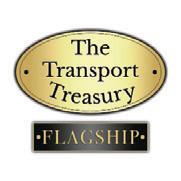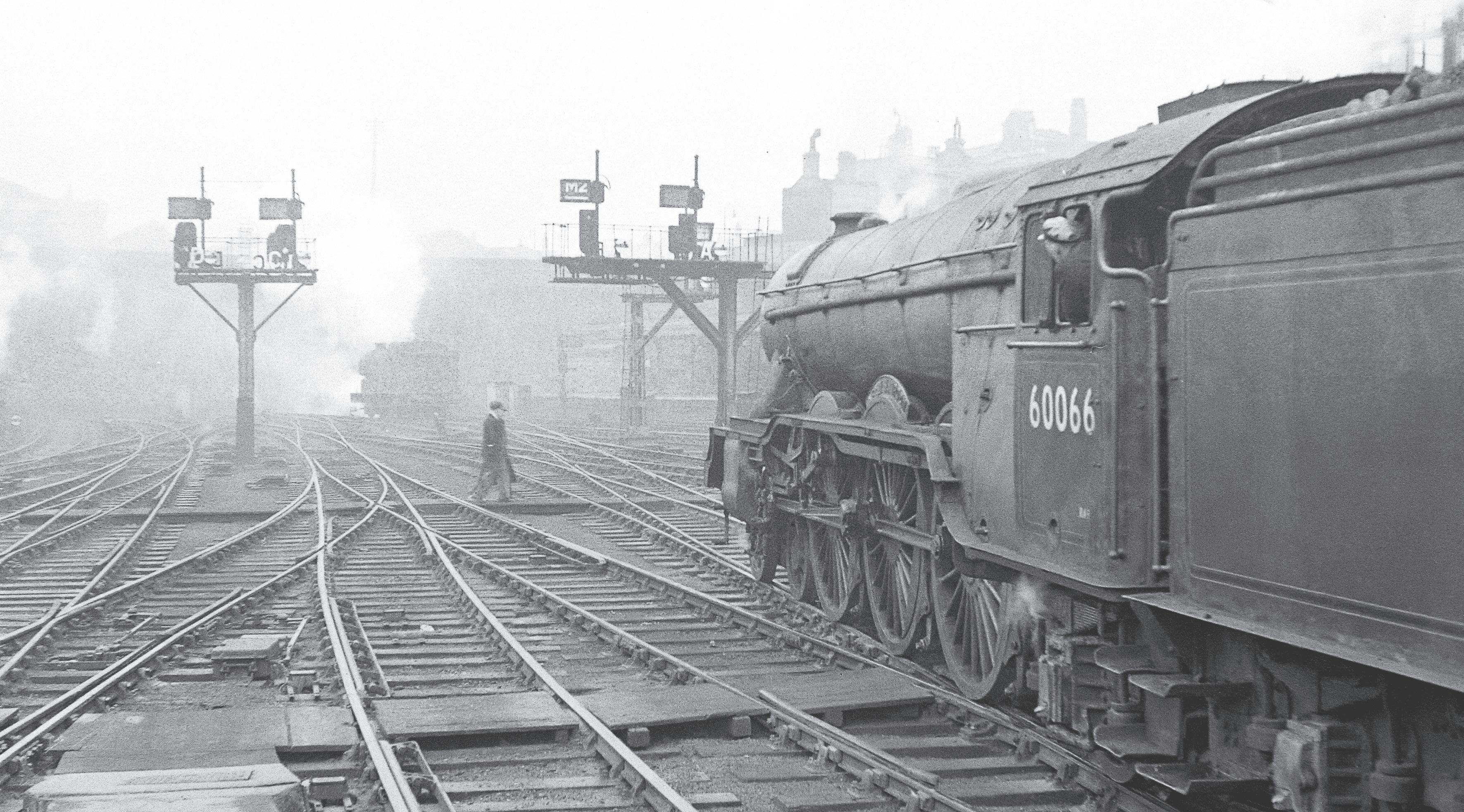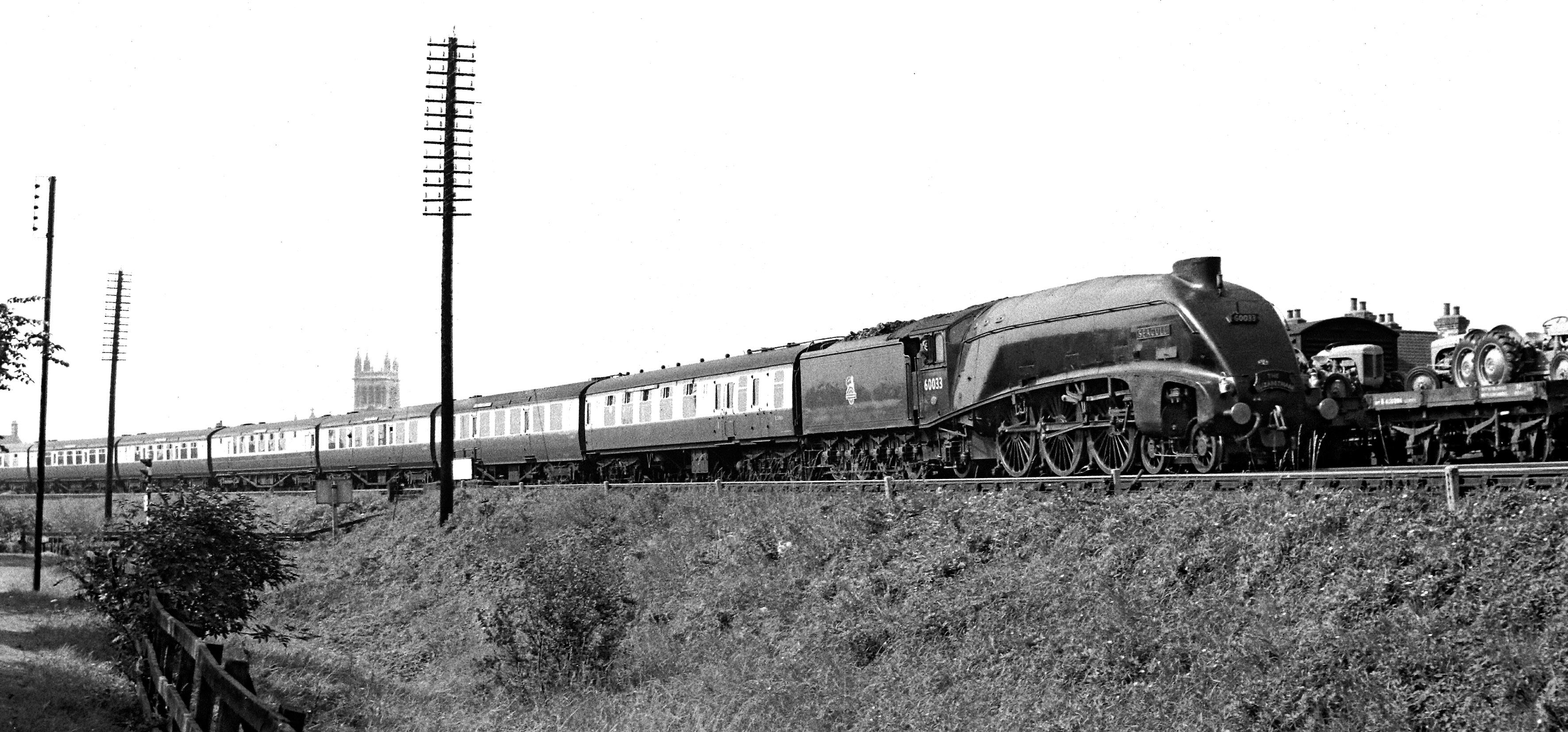

The Atmospheric Eastern
The Classic Eastern Region Collection

Images from the Transport Treasury
Described by Alan C Butcher
It’s 2.30pm and two of Gresley’s finest stand at the buffer stops at King’s Cross, and the scene oozes with the atmosphere of the period – and, although taken around 60 years ago, a number of the companies advertising their services are still around today. Nearest the camera is an unidentified ‘A3’, complete with double-chimney and ‘elephant ear’-style smoke deflectors. The ‘A4’ is No 60010 Dominion of Canada, built at Doncaster Works; it entered traffic on 4th May 1937 for running in as No 4489 Woodcock – less than two weeks later, on the 17th, it returned to the works for repainting and renaming. Under the LNER’s locomotive 1946 renumbering scheme it gained the number 10 on 10th May 1946, and its final BR number on 27th October 1948 followed a light repair at Doncaster Works. Although the image is undated it postdates December 1957 as the locomotive is fitted with a double-chimney as the bell in front of the chimney has been removed. After a service life of just over 28 years

it was withdrawn from Aberdeen Ferryhill depot at the end of May 1965, and following open-air storage at Darlington Bank Top shed it was sent to Crewe in August 1966 for restoration externally in BR livery, having been donated to the Canadian Railroad Historical Association by British Rail. It was shipped to Canada via Southampton Docks in April the following year. In October 2012 it visited the UK for the 75th Anniversary of Mallard’s record-breaking run. During the visit, the National Railway Museum restored it back to 1930s condition in LNER Garter Blue complete with the ceremonial bell it carried when new. It returned to the Exporail Canadian Railway Museum in May 2014. George Heiron (262)

Edinburgh’s Waverley station is situated in a steep, narrow valley between the medieval Old Town and the 18th century New Town. Princes Street, the premier shopping street, runs close to its north side. The valley is bridged by the North Bridge, rebuilt in 1897 as a three-span iron and steel bridge, on huge sandstone piers. This passes high above the station’s central section, directly over the central booking hall (which cleverly hides one of the main stone piers within its bulk). Waverley Bridge lies to the west side of the station (though platforms extend below it) and it is this road which, by means of ramps, formerly afforded vehicular access to the station and still provides two of the six pedestrian entrances to the station. The valley to the west, formerly the site of the Nor Loch, is the public parkland of Princes Street Gardens. From 1866-1868, the North British Railway acquired the stations of its rivals, demolished all three and closed the Scotland Street tunnel to Canal Street. The present Victorian station was built on the site. Along the tracks of this first station, Hanna, Donald & Wilson built some very impressive roofs. The station was extended in the late 19th century. In 1897, the impressive glass dome was added. From its opening in its current form by the eastward tunnelled extension from Haymarket, Waverley has been the principal railway station in Edinburgh. For over 90 years the city had a second major station, Princes Street (opened 2nd May 1870, closed 6th September 1965), operated by the rival Caledonian Railway, but this was never as important as Waverley. Class K2 No 61770 leaves Waverley with a westbound local service during the summer of 1955 passing through East Princes Street Gardens. Built by Kitson & Co, Hunslet, Leeds, (Works No 5330) as No 1680 it entered service during June 1921, initially allocated to Peterborough’s New England depot. Renumbered 4860 at the time of the Grouping, it gained its 1946 number, 1770, on 13th June 1946 following a General overhaul at Cowlairs Works. It gained its BR number following a further General overhaul, again at Cowlairs, on 6th November 1948. It arrived at its first locomotive depot in Scotland (Eastfield in Glasgow) in January 1951; and arrived at its final Scottish depot, Dunfermline Upper, on 28th September 1952 from where it was withdrawn on 8th July 1959. Neville Stead (NS 202477)

Princes Street Gardens are two adjacent public parks in the centre of Edinburgh, lying in the shadow of Edinburgh Castle. The Gardens were created in the 1820s following the draining of the Nor Loch and building of the New Town, beginning in the 1760s. The loch, situated on the north side of the town, was originally an artificial creation forming part of its medieval defences and made expansion northwards difficult. The water was habitually polluted from sewage draining downhill from the Old Town. The gardens run along the south side of Princes Street and are divided by The Mound, on which the National Gallery of Scotland and the Royal Scottish Academy buildings are located. East Princes Street Gardens run from The Mound to Waverley Bridge, and cover 8.5 acres (3.4ha). The larger West Princes Street Gardens cover 29 acres (12ha) and extend to the adjacent churches of St John’s and St Cuthbert’s, near Lothian Road in the west. In 1846 the railway was built in the valley to connect the Edinburgh-Glasgow line at Haymarket with the new northern terminus of the NBR line from Berwick-upon-Tweed at Waverley station. Designed by Arthur Peppercorn, Class A1 No 60160 Auld Reekie is seen passing through West Princes Street Garden, with the National Gallery above the tunnel, during 1954. It was allocated new to the local Haymarket depot, arriving on 2nd December 1949 from Doncaster Works. Always a Scottish allocated locomotive, it ended its days at St Margaret’s depot on 12th December 1963; arriving at Darlington Works for recycling in March the following year. Neville Stead (NS207446)



Top left. The original terminus station at Selby was opened in 1834 for the Leeds & Selby Railway. The Hull & Selby Railway extended the line in 1840, and a new station was built, with the old station becoming a goods depot. The station was rebuilt in 1873 and 1891, the 1891 rebuilding being required due to the replacement of the swing bridge over the Ouse at the same time. The area around the station has been the location for the junctions of a number of lines, including the former East Coast main line route between Doncaster and York, as well as the Selby to Driffield line (dating from 1848), and the Selby to Goole line (1910). After 1983 with the opening of the Selby Diversion, the town is no longer on the East Coast main line, today the station building, dating from 1891, is a Grade II listed structure. Class D20 No 62384 was allocated to the nearby depot, being withdrawn from there on 15th August 1955, and is seen during 1952 departing with an express passenger service. It was built by the NER at its Gateshead Works in June 1907 as No 1184. Being renumbered in February 1946 as 2384. It gained its BR number on 16th September 1950 and survived in traffic until condemned on 15th August 1955 whilst stationed at the nearby depot that was situated in the vee of the junction between the lines to Doncaster and Leeds. The shed was a standard NER roundhouse design being a square overall shed, with 20 tracks. The shed was extended to a similar extent in 1896-8 with an adjacent square shed. It was closed on 13th September 1959 and demolished a few years later Neville Stead (NS200117A)
Bottom left. Gresley ‘A4’ No 60033 Seagull heads the ‘Elizabethan’ express at Selby, sometime after December 1953 as it carries the later short guard irons. Built at Doncaster Works as No 4902 it entered traffic on 28th June 1938, being allocated to King’s Cross. Under the 1946 renumbering scheme it became No 33, on 31st October 1946, gaining its BR number on 10th April 1948 following an unclassified overhaul. Apart from a brief period allocated to Grantham it spent its BR days allocated to King’s Cross’ ‘Top Shed’ depot, being withdrawn from there on 29th December 1962. Neville Stead (NS206389)
Above. Designed for the NER by Wilson Worsdell as an ‘O’ class 0-4-4T, No 1837 entered traffic during March 1895 having been out-shopped from Darlington Works. It became a member of the LNER’s ‘G5’ class following the grouping and retained its original number until June 1946 when it became 7250. During November 1940 it was fitted with Push/Pull equipment, seen to the left of the smokebox, whilst the buffer beam also sports the additional ‘pipework’ required to operate the vacuum-based system. It gained its BR identity during August 1948 and is seen here with the new owner’s name in full on the side tanks passing under Bawtry Road bridge heading south along the main line to Doncaster. No 67250 had arrived at Selby during August 1950, remaining there until withdrawn on 16th September 1957. Neville Stead (NS200122A)
Pacifics awaiting departure from King’s Cross with No 60030 waiting to take the ‘Tees-Tyne’ express northwards. New to traffic on 26th November 1948, No 60136 Alcazar was a member of Arthur Peppercorn’s Class A1 Pacifics and was constructed at Darlington Works; its initial allocation was to Copley Hill (Leeds). It was reallocated to King’s Cross on 21st May 1950 then spent the next 13 years allocated there, Grantham and Doncaster where it arrived for a final time on 5th May 1959. It was withdrawn from there on 22nd May 1963 – being allocated to the adjacent works for recycling a few days later. On the nearer platform is one of Gresley’s finest, A4 class No 60030 Golden Fleece. It emerged from Doncaster Works and entered traffic at the nearby depot on 30th August 1937 in Apple Green livery as No 4495 Great Snipe. Its original nameplates were removed on 11th September 1937 as it had been returned to the works to be repainted in Garter blue, emerging on the 25th as Golden Fleece. On 23rd November 1946 it was renumbered 30 following a General overhaul at Doncaster Works, final renumbering to 60030 occurred on 30th June 1948, again following a works overhaul. From 24th September 1937 it spent its life allocated to either Grantham or King’s Cross from where it was withdrawn on 29th December 1962, and, as with 60136, consigned to Doncaster Works for dismantling. George Heiron (267)


The south-bound ‘Elizabethan’ arrives at King’s Cross behind No 60009 Union of South Africa, sometime prior to September 1952 when the long ‘guard irons’ were removed during a General overhaul at Doncaster Works. Originally intended to be named ‘Osprey’, when delivered from Doncaster Works it was allocated to Haymarket as No 4488 carrying Garter blue livery and its new name. Reallocated to Aberdeen Ferryhill depot on 20th May 1962, the locomotive was to spend much of its working life on the three-hour services between Aberdeen and Glasgow. Condemned on 1st June 1966, it was fitted with a corridor tender and sold into preservation. Across the adjacent platform Class N1 0-6-2T No 69441 is waiting to take the stock of the previous arrival to the carriage depot for servicing. Built by the GNR in March 1910 as No 1561, it was renumbered 4561 by the LNER during May 1926 and again in September 1946 as No 9441. Following its stint in London it was sent north in the spring of 1954, initially to Colwick and a year later to Bradford Hammerton Street from where it was withdrawn in late May 1955 as No 69441. George Heiron (250)

From London Kings Cross to Fraserburgh, from bucolic branch lines to the hives of industry, the London & North Eastern Railway had it all. Its range of motive power was tremendous, from Pugs pootling around goods yards to streamlined Pacifics streaking through the landscape. With good bits, bad bits and in some cases the downright ugly bits all adding to the atmosphere that stretched from the banks of the Thames to the northern coast of Scotland – the 6,500 route miles were full of contrast. Many of the inherited locomotives and rolling stock did well to survive into the Nationalised era – the LNER, as a company was never flush with cash. It was however full of new ideas, from steam railcars to electrification – not always successful – that was to capture the public’s attention. The sheer variety of motive power, rolling stock and goods traffic certainly contributed to the flavour of the times.
‘I was once told that one man’s atmosphere is another man’s smog, so I hope you enjoy our perambulation around the LNER, its precedents and antecedents.’


£29.95


